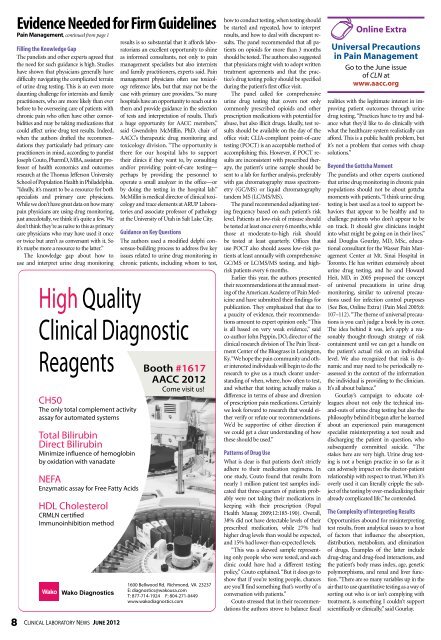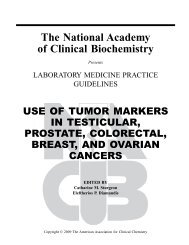June 2012 - American Association for Clinical Chemistry
June 2012 - American Association for Clinical Chemistry
June 2012 - American Association for Clinical Chemistry
Create successful ePaper yourself
Turn your PDF publications into a flip-book with our unique Google optimized e-Paper software.
Evidence Needed <strong>for</strong> Firm Guidelines<br />
Pain management, continued from page 1<br />
Filling the Knowledge Gap<br />
The panelists and other experts agreed that<br />
the need <strong>for</strong> such guidance is high. Studies<br />
have shown that physicians generally have<br />
difficulty navigating the complicated terrain<br />
of urine drug testing. This is an even more<br />
daunting challenge <strong>for</strong> internists and family<br />
practitioners, who are more likely than ever<br />
be<strong>for</strong>e to be overseeing care of patients with<br />
chronic pain who often have other comorbidities<br />
and may be taking medications that<br />
could affect urine drug test results. Indeed,<br />
when the authors drafted the recommendations<br />
they particularly had primary care<br />
practitioners in mind, according to panelist<br />
Joseph Couto, PharmD, MBA, assistant professor<br />
of health economics and outcomes<br />
research at the Thomas Jefferson University<br />
School of Population Health in Philadelphia.<br />
“Ideally, it’s meant to be a resource <strong>for</strong> both<br />
specialists and primary care physicians.<br />
While we don’t have great data on how many<br />
pain physicians are using drug monitoring,<br />
just anecdotally, we think it’s quite a few. We<br />
don’t think they’re as naïve to this as primary<br />
care physicians who may have used it once<br />
or twice but aren’t as conversant with it. So<br />
it’s maybe more a resource to the latter.”<br />
The knowledge gap about how to<br />
use and interpret urine drug monitoring<br />
8 CliniCal laboratory news <strong>June</strong> <strong>2012</strong><br />
results is so substantial that it af<strong>for</strong>ds laboratorians<br />
an excellent opportunity to shine<br />
as in<strong>for</strong>med consultants, not only to pain<br />
management specialists but also internists<br />
and family practitioners, experts said. Pain<br />
management physicians often use toxicology<br />
reference labs, but that may not be the<br />
case with primary care providers. “So many<br />
hospitals have an opportunity to reach out to<br />
them and provide guidance in the selection<br />
of tests and interpretation of results. That’s<br />
a huge opportunity <strong>for</strong> AACC members,”<br />
said Gwendolyn McMillin, PhD, chair of<br />
AACC’s therapeutic drug monitoring and<br />
toxicology division. “The opportunity is<br />
there <strong>for</strong> our hospital labs to support<br />
their clinics if they want to, by consulting<br />
and/or providing point-of-care testing—<br />
perhaps by providing the personnel to<br />
operate a small analyzer in the office—or<br />
by doing the testing in the hospital lab.”<br />
McMillin is medical director of clinical toxicology<br />
and trace elements at ARUP Laboratories<br />
and associate professor of pathology<br />
at the University of Utah in Salt Lake City.<br />
Guidance on Key Questions<br />
The authors used a modified delphi consensus-building<br />
process to address five key<br />
issues related to urine drug monitoring in<br />
chronic patients, including whom to test,<br />
High Quality<br />
<strong>Clinical</strong> Diagnostic<br />
Reagents<br />
CH50<br />
The only total complement activity<br />
assay <strong>for</strong> automated systems<br />
Total Bilirubin<br />
Direct Bilirubin<br />
Minimize inuence of hemoglobin<br />
by oxidation with vanadate<br />
NEFA<br />
Enzymatic assay <strong>for</strong> Free Fatty Acids<br />
HDL Cholesterol<br />
CRMLN certied<br />
Immunoinhibition method<br />
Wako Diagnostics<br />
Booth #1617<br />
AACC <strong>2012</strong><br />
Come visit us!<br />
1600 Bellwood Rd. Richmond, VA 23237<br />
E: diagnostics@wakousa.com<br />
T: 877-714-1924 F: 804-271-0449<br />
www.wakodiagnostics.com<br />
how to conduct testing, when testing should<br />
be started and repeated, how to interpret<br />
results, and how to deal with discrepant results.<br />
The panel recommended that all patients<br />
on opioids <strong>for</strong> more than 3 months<br />
should be tested. The authors also suggested<br />
that physicians might wish to adopt written<br />
treatment agreements and that the practice’s<br />
drug testing policy should be specified<br />
during the patient’s first office visit.<br />
The panel called <strong>for</strong> comprehensive<br />
urine drug testing that covers not only<br />
commonly prescribed opioids and other<br />
prescription medications with potential <strong>for</strong><br />
abuse, but also illicit drugs. Ideally, test results<br />
should be available on the day of the<br />
office visit; CLIA-compliant point-of-care<br />
testing (POCT) is an acceptable method of<br />
accomplishing this. However, if POCT results<br />
are inconsistent with prescribed therapy,<br />
the patient’s urine sample should be<br />
sent to a lab <strong>for</strong> further analysis, preferably<br />
with gas chromatography mass spectrometry<br />
(GC/MS) or liquid chromatography<br />
tandem MS (LC/MS/MS).<br />
The panel recommended adjusting testing<br />
frequency based on each patient’s risk<br />
level. Patients at low-risk of misuse should<br />
be tested at least once every 6 months, while<br />
those at moderate-to-high risk should<br />
be tested at least quarterly. Offices that<br />
use POCT also should assess low-risk patients<br />
at least annually with comprehensive<br />
GC/MS or LC/MS/MS testing, and highrisk<br />
patients every 6 months.<br />
Earlier this year, the authors presented<br />
their recommendations at the annual meeting<br />
of the <strong>American</strong> Academy of Pain Medicine<br />
and have submitted their findings <strong>for</strong><br />
publication. They emphasized that due to<br />
a paucity of evidence, their recommendations<br />
amount to expert opinion only. “This<br />
is all based on very weak evidence,” said<br />
co-author John Peppin, DO, director of the<br />
clinical research division of The Pain Treatment<br />
Center of the Bluegrass in Lexington,<br />
Ky. “We hope the pain community and other<br />
interested individuals will begin to do the<br />
research to give us a much clearer understanding<br />
of when, where, how often to test,<br />
and whether that testing actually makes a<br />
difference in terms of abuse and diversion<br />
of prescription pain medications. Certainly<br />
we look <strong>for</strong>ward to research that would either<br />
verify or refute our recommendations.<br />
We’d be supportive of either direction if<br />
we could get a clear understanding of how<br />
these should be used.”<br />
Patterns of Drug Use<br />
What is clear is that patients don’t strictly<br />
adhere to their medication regimens. In<br />
one study, Couto found that results from<br />
nearly 1 million patient test samples indicated<br />
that three-quarters of patients probably<br />
were not taking their medications in<br />
keeping with their prescription (Popul<br />
Health Manag 2009;12:185-190). Overall,<br />
38% did not have detectable levels of their<br />
prescribed medication, while 27% had<br />
higher drug levels than would be expected,<br />
and 15% had lower-than-expected levels.<br />
“This was a skewed sample representing<br />
only people who were tested, and each<br />
clinic could have had a different testing<br />
policy,” Couto explained. “But it does go to<br />
show that if you’re testing people, chances<br />
are you’ll find something that’s worthy of a<br />
conversation with patients.”<br />
Couto stressed that in their recommendations<br />
the authors strove to balance fiscal<br />
online extra<br />
universal Precautions<br />
in Pain management<br />
go to the <strong>June</strong> issue<br />
of CLN at<br />
www.aacc.org<br />
realities with the legitimate interest in improving<br />
patient outcomes through urine<br />
drug testing. “Practices have to try and balance<br />
what they’d like to do clinically with<br />
what the healthcare system realistically can<br />
af<strong>for</strong>d. This is a public health problem, but<br />
it’s not a problem that comes with cheap<br />
solutions.”<br />
Beyond the Gottcha Moment<br />
The panelists and other experts cautioned<br />
that urine drug monitoring in chronic pain<br />
populations should not be about gottcha<br />
moments with patients. “I think urine drug<br />
testing is best used as a tool to support behaviors<br />
that appear to be healthy and to<br />
challenge patients who don’t appear to be<br />
on track. It should give clinicians insight<br />
into what might be going on in their lives,”<br />
said Douglas Gourlay, MD, MSc, educational<br />
consultant <strong>for</strong> the Wasser Pain Management<br />
Center at Mt. Sinai Hospital in<br />
Toronto. He has written extensively about<br />
urine drug testing, and he and Howard<br />
Heit, MD, in 2005 proposed the concept<br />
of universal precautions in urine drug<br />
monitoring, similar to universal precautions<br />
used <strong>for</strong> infection control purposes<br />
(See Box, Online Extra) (Pain Med 2005;6:<br />
107–112). “The theme of universal precautions<br />
is you can’t judge a book by its cover.<br />
The idea behind it was, let’s apply a reasonably<br />
thought-through strategy of risk<br />
containment until we can get a handle on<br />
the patient’s actual risk on an individual<br />
level. We also recognized that risk is dynamic<br />
and may need to be periodically reassessed<br />
in the context of the in<strong>for</strong>mation<br />
the individual is providing to the clinician.<br />
It’s all about balance.”<br />
Gourlay’s campaign to educate colleagues<br />
about not only the technical insand-outs<br />
of urine drug testing but also the<br />
philosophy behind it began after he learned<br />
about an experienced pain management<br />
specialist misinterpreting a test result and<br />
discharging the patient in question, who<br />
subsequently committed suicide. “The<br />
stakes here are very high. Urine drug testing<br />
is not a benign practice in so far as it<br />
can adversely impact on the doctor-patient<br />
relationship with respect to trust. When it’s<br />
overly used it can literally cripple the subject<br />
of the testing by over-medicalizing their<br />
already complicated life,” he contended.<br />
The Complexity of Interpreting Results<br />
Opportunities abound <strong>for</strong> misinterpreting<br />
test results, from analytical issues to a host<br />
of factors that influence the absorption,<br />
distribution, metabolism, and elimination<br />
of drugs. Examples of the latter include<br />
drug-drug and drug-food interactions, and<br />
the patient’s body mass index, age, genetic<br />
polymorphisms, and renal and liver function.<br />
“There are so many variables up in the<br />
air that to use quantitative testing as a way of<br />
sorting out who is or isn’t complying with<br />
treatment, is something I couldn’t support<br />
scientifically or clinically,” said Gourlay.
















